




Poof, just like that, 2022 is gone and 2023 is upon us.
January is a month of hope and aspirations as we reassess, look forward and make resolutions.
For some, it’s all about less: less sugar consumption, less weight and less stress. For the magazine, our resolutions focus on more. Looking ahead, our goal is to have more features, more variety and more pages. We have a whole file-cabinet worth of story ideas, which we can’t wait to share.
But we’re the first to admit: putting out a magazine can be a stressful business.
When things aren’t going smoothly — stories fall through and we’re pummeled by deadlines — we find that a little fresh air and a walk will refocus and rejuvenate our efforts. With that in mind, we’ve put together a month-by-month list of ideas that will hopefully inspire you to take a step back, get outside and enjoy Coronado’s enviable setting, which can be taken for granted when life gets busy.
Ben Vaughan took the idea of getting outside and amplified it — a lot. After retiring from the Navy, Vaughan decided to hit the trail to figure out his life. But this wasn’t just a day outing. Vaughan trekked the Appalachian Trail. Other trails came next; among them the Pacific Crest Trail and the Continental Divide Trail. His story (page 4) is just the kind of inspiration needed to get the new year off right.
We know there are challenges ahead, but we are excited to see what 2023 will bring. We’re glad you are along for the ride.
IN BLOOM THIS MONTH: Hellebore


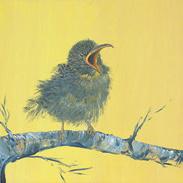


CONTACT editor@coronado365.com or (619) 435-0334
CORONADO 365 is a division of Now and Then Publishing LLC, 830 Orange Ave., Suite B, Coronado, CA 92118

Copyright ©2023 Now and Then Publishing LLC All rights reserved. Reproduction of any material in whole or in part without written permission is prohibited.



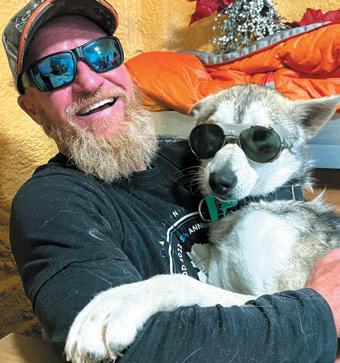 By NICOLE SOURS LARSON
By NICOLE SOURS LARSON
What inspires a Navy vet turned program manager to morph into a “Triple Crown” thru-hiker and Alaskan dogsled musher and kennel manager?
A standard desk job spent sitting at a computer was never going to suit Ben Vaughan, who called Coronado home from 2009 through 2015, following his retirement from a 22-year military career.
He had joined the Navy after high school in Florida as an enlisted ops specialist, retiring as a lieutenant commander surface warfare officer with two master’s degrees. In retrospect, he said, the Navy turned out to be a sound choice that shaped his future.
A committed runner, skier, triathlete and single father — as well as inveterate thrill-seeker — Vaughan, 54, retired early and settled in Coronado because his daughter, Jordan, came to live
Ben Vaughan with an Alaskan husky pup he trains in Talkeetna, Alaska.
Left, Vaughan treks through a slot canyon on the 800-mile Hayduke Trail in Northern Arizona and Utah.
with him when she was 13. He was worn down after three combat deployments in four years, including two to Iraq. He knew he couldn’t be a responsible father to his daughter, now 29, if he accepted a fourth deployment, this time to Afghanistan. They remain incredibly close, he said. And he’s also tight with his 32-year-old son, Josh, who lives with his family in Kansas.
Vaughan chose Coronado as home because he wanted Jordan to attend Coronado High School.
“The high school facilitates kids’ growth. It’s where, not if, you’re going to college,” he said, praising the school’s programs, which provided his daughter the skills to excel at University of California Santa Barbara.
Vaughan worked as a program manager for a defense contractor during his Coronado years, all the while wrestling with his inner conflicts, trying to find his way in civilian life.
“It was good money, but a poor lifestyle. I’d rather have less money and a better lifestyle,” Vaughan said.
While other vets channeled their transitioning difficulties into unhealthy behaviors, Vaughan turned to exercise and outdoor pursuits.
“The first few years I was kind of lost, trying to figure things out. My ‘addiction’ is anything I’m involved in. I was into skydiving, triathlons, hiking. I did five Ironmans. Whatever I do, I’m all in, 100 percent,” Vaughan explained.
Longtime Coronado friend Andrea Dodson, who met him about 14 years ago, credits Vaughan with introducing her to running, sharing his passion for its benefits for both mind and body. She and many others volunteered when Vaughan organized the first Coronado Valentine’s Day 10K race in 2010.
“He did struggle after the Navy. A lot of the (physical) activities helped him through this. His love and his zest for life and friends have kept him going and in a great place,” Dodson said. “Ben is very adventurous. He’s always going after everything 100 percent. He loves the thrill of it all.”
Once Jordan finished college, Vaughan felt comfortable leaving his unfulfilling desk job. He moved to Virginia Beach, Virginia, where he worked with a company organizing races, a natural fit for this lifelong runner. Still, something was missing, and he continued to struggle with civilian life.

“Thru-hiking allowed me to figure out my life and how I wanted to live my life.”



In 2018, he sold almost everything he owned, re-homed his beloved yellow Labrador, Alice, with good friends in Virginia Beach and took off to hike the Appalachian Trail. He hiked the entire 2,193 miles in 4½ months, the first of three in the “Triple Crown” of renowned thru-hiking trails. He completed the 2,653-mile Pacific Crest Trail in 2019 and the 3,100-
mile Continental Divide Trail in 2020, both linking Mexico to Canada. Vaughan is one of only about 500 people to finish the thru-hiking trifecta.
Hiking mostly alone, occasionally joining trekkers he met along the way, he began to find his peace. Vaughan gradually recognized and accepted his “best life” involved adventure and an outdoor lifestyle.

“Thru-hiking allowed me to figure out my life and how I wanted to live my life,” he said.
Michelle Gilmore, another longtime friend who volunteered for Vaughan’s Valentine’s Day 10K, recognized his old struggles and his newer roles.
“He always wanted people to succeed and wanted to bring the quality up around
him. He was always looking for something that would fulfill his creativity and scratch his itch,” said Gilmore, who now serves as president and CEO of the Coronado Schools Foundation.
Alone in the wilderness, Vaughan gained additional survival skills, experiencing encounters with wild animals and the constant risk of serious injury — even
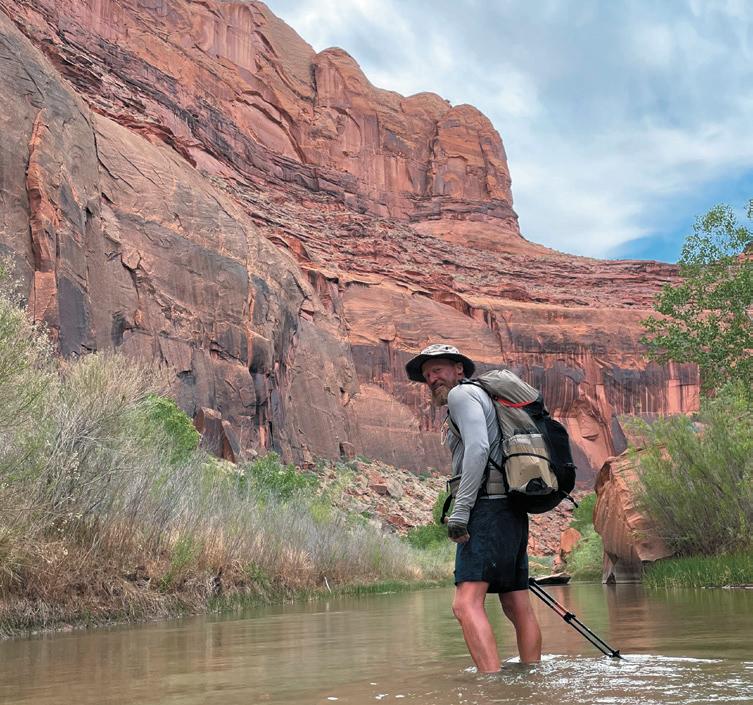
death. He also learned not to underestimate the dangers of nature, especially snowstorms. While hiking in the Sierra mountains along the Pacific Crest Trail, a blizzard trapped him for 24 hours. He was fortunate to make it out alive, but developed serious frostbite on four toes, forcing him to seek medical treatment and spend three weeks recovering off the trail.
The COVID-19 pandemic didn’t derail or impact his hiking; he walked alone along the Continental Divide Trail during 2020. In 2021, also a solo trip, he took on the rugged, challenging 800-mile Hayduke Trail, which winds through national parks in Utah and Northern Arizona, starting in Arches National Park in Utah and ending in Zion National Park in Utah. He often didn’t see anyone for many days.
“Hayduke is more route-finding with no trail signage, requiring land navigation skills while walking through washes, canyons, deserts, mountains and 150 miles by the Grand Canyon. It’s the Ph.D. of thru-hiking,” he explained, the most demanding outdoor experience of his life.
After Hayduke, Vaughan notched Minnesota’s 310-mile Superior Hiking Trail and the 273-mile Vermont Long Trail, bringing his distance tally to more than 10,000 thru-hiking miles since 2018.
Winters were spent as a ski and snowboarding instructor in Winter Park, Colorado.
He intended to hike the 1,200-mile Pacific Northwest Trail, from Montana to the Washington coast, in 2021, but his life changed abruptly that summer. Vaughan received a text from a friend asking if he
would be interested in going to Talkeetna, Alaska. Five-time Iditarod race winner Dallas Seavey was looking to train someone to help with his dog mushing business.
The first summer season proved so challenging and enjoyable, Vaughan returned last summer and plans to stay this winter and, perhaps, long term.
Drawing on his strong Navy-bred skills, he’s now managing AK Sled Dog Tours, the full-service mushing center, overseeing the kennels, mushers, tour operations, and he works with Seavey training of 120 world-class Alaskan huskies, a specialized breed. He’s also preparing for a 200-mile race this month with 14 dogs, though he admits to feeling more comfortable running 10 dogs.
Vaughan draws parallels between thru-hiking and mushing.
“It’s you against the elements. You have to plan properly or you’ll find yourself in a bad situation, with hiking or dog mushing. When you go out in the backcountry, you have to have all provisions for both you and the dogs,” he explained.
Vaughan, always with an eye out for a new adventure, has found his latest and perhaps greatest adventure in Alaska, with his past transitional difficulties in the rearview mirror.
What would he like old friends in Coronado to know about him now?
“I’m happy.”
Follow Ben Vaughan’s latest adventures on Instagram, @hiking_ginger_b. ■
Nicole Sours Larson is a freelance writer.


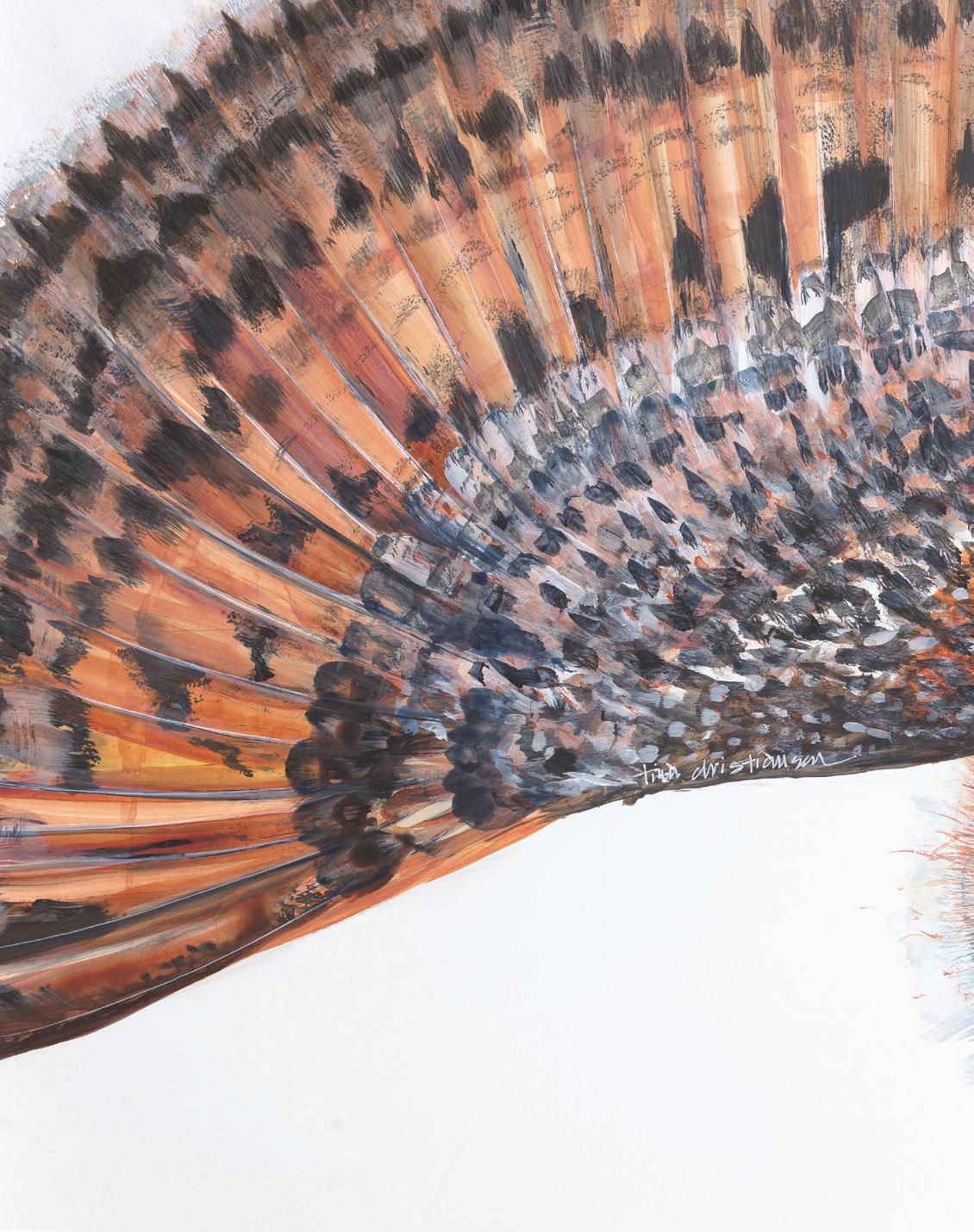


 By CATHERINE GAUGH
By CATHERINE GAUGH
Tina Christiansen was painting on the beach when she looked up and witnessed a magical moment of nature. The ocean was smooth, almost glassy, and reflected the mass of slow-moving clouds overhead in shades of blue. The sensation of seeing clouds above and clouds below gave her a bit of vertigo.
She grabbed a camera and captured this wondrous image. She had two reasons: one, to prove that it happened. And two, to paint it.
“Blue Clouds on the Sea” is one of the artist’s most riveting ocean scenes. After 30 years of painting, Christiansen still loves the beach. Her other favorite subjects include predatory birds in flight, butterflies and the creatures of the undersea world.
Q: Your biography states that you intended to major in art at the University of Florida but changed your mind and studied architecture.
A: I have always wanted to be a structural engineer and an artist. In school, I realized that I might not be able to make a living from art. Architecture is very obviously
« “Flying Turtle” was painted from a photo Tina Christiansen took underwater as the turtle seemed to fly by her.
“What is intriguing about art is that you can’t really explain it.”
TINA CHRISTIANSENJOE CRAIG | BLACK LABEL PHOTOGRAPHY
intensive, but I really liked it. I designed banks; I learned a lot about security systems.
Q: What is your connection with Coronado?
A: My dad was Navy, so wherever we lived, it was close to a beach. I went to three different high schools, and one was here in Coronado. I loved it here. When my husband, James Cauthorn, who is also an architect, and I had a chance to move from Colorado to San Diego, we jumped at the chance. We built our little house in the alley in 1990.
Q: Tell me about your architecture career. How much time did you have to paint?
A: Architecture is a great career. After graduation, I joined a firm. I saved up some money to get my master’s at Virginia Tech. When a recession hit, there was not a lot of work for the firm. I applied to be a building official for the city of Boulder, Colorado, checking plans, overseeing building inspections, things like that. I really liked it. I was the chief building official for the city of San Diego for many years. Then I worked for the city of Irvine and was director of community development for Solana Beach. I retired in 2014.
Through the working years, I painted on weekends or late into the night. I’d finish two or sometimes three paintings a month. Now I paint three to four a week.
Q: How does your architect training and experience influence your art?
A: I always look for structures and natural forms. I’m intrigued by the underlying forms and lines beneath the surface. For the “Blue Clouds” painting, I utilized a two-point vanishing perspective grid as the structure and laid out the optics and geometry to show the reflection of the clouds in the pools of water, as if the ocean was a mirror. The geometry of perspective can get tricky, so I’m not a slave to it.
I work with a company in China to imprint one of my paintings every year on silk for scarves. This year, the scarves are of “Blue Clouds.” The luminosity of the silk transcends the colors better than the original painting.

Q: The images of the creatures in your underwater paintings are remarkable. How do you capture them?
A: I love to snorkel and catch images with my camera underwater. It took me awhile, but it struck me that while I am doing that, the ocean creates what I perceive as a very large room with a dramatic ceiling of light above me and wild patterns of refracted sunlight below.
I took a photo of a turtle that swam by me. Later I realized that the turtle was flying through the water, the same way birds
can fly through the air. It’s amazing.
Q: Given the variety of styles and subjects, how would you describe your art?

A: What is intriguing about art is that you can’t really explain it. Someone can paint a pretty picture, and that’s good art. I want to transcend that and produce great art.
I don’t look just at the surface. I look for the light and the shadows, and when I see a turtle or a fish or a bird, I look them right in the eyes and see them as beings.
An egret in the evening sun is part of Tina Christiansens “Flyers and Swimmers” series.

I see their attitude, their mood. Great art captures both the spirit and the structure. It’s painting what you see and what you don’t see.
Great architecture seeks to define space and tone. So does art.
Q: Where can people see your work?
A: My website is tinachristiansen.net. I’m on Facebook and Instagram. Also, see coronadoartcolony.com. You can see one of my mermaid paintings at Chase Bank, 1000 Orange Ave.
Q: You had a gallery in town for several years and taught art classes. What advice would you give aspiring artists?
A: Learning to be a great artist is like
learning a new and complex language. The same as architecture, art is worthy of a lifetime of studies. You are never a master of all things related to it. You can only hope to progress to a higher level of skill and understanding.
If you want to be a great artist, you need to explore and experiment with different materials and various types of brushes. There are rhythms to brush strokes; develop your own.
I don’t know if I’m a great painter yet, but I intend to spend my life working to be as great as I can be. Claude Monet did his best work after the age of 75. I’m 68, so I might be on my way. ■
Catherine Gaugh is a freelance writer.


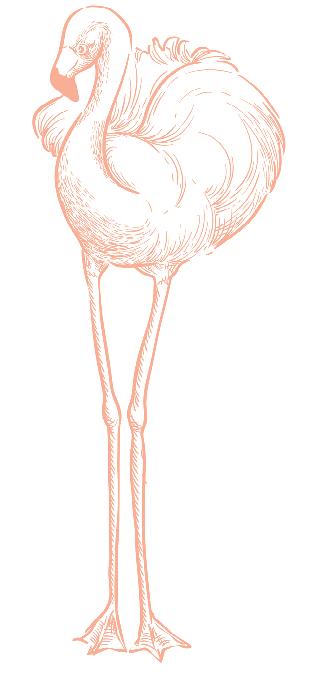 Pink Floyd is not just another bird on the bay
By MARTINA SCHIMITSCHEK
Pink Floyd is not just another bird on the bay
By MARTINA SCHIMITSCHEK
Since 2018, an escapee has been seeking refuge in south San Diego Bay. The runaway has been seen by many, but no one has ever come close enough to get any information on the elusive exile.
Even the gender hasn’t been determined, although some locals call him — or her — Pink Floyd. And like the members of the ’70s band, Floyd has become a bit of a rock star.
Floyd is a flamingo, most likely an American flamingo, Phoenicopterus ruber, a subspecies of the greater flamingo. American flamingos, the most brightly colored bird of the species, are native to Mexico, the Caribbean and the northernmost tip of South America, according to the San Diego Zoo Wildlife Alliance.
The South Bay flamingo is believed to have escaped from a private owner, possibly from Mexico. When the bird was first sighted, the zoo and SeaWorld were contacted, but neither organization was missing a flamingo.
« This photo of the South Bay flamingo known as Pink Floyd was taken in June 2020, just south of the Coronado Cays. ROGER UZUN
While most of us have seen flamingos in captivity, it’s a special thrill to see one in the wild. The species has been fascinating humans for centuries. A cave painting in Spain dating to 5,000 B.C. includes an image of a flamingo. Some details about the distinctive bird:
• Vocalizations include growling, low gabbling and nasal honking.
• There are many theories, but no definitive explanation why flamingos stand on one leg. It might just be because it’s comfortable.
• Flamingos eat by holding their bill upside down in the water and sucking water and mud in at the front and then pumping it out at the sides. Filter-like plates trap shrimp and other small water creatures for the birds to eat.
• Before taking off in flight, flamingos need to run to gather speed. In flight, they flap their wings fairly rapidly and almost continuously.
• Flamingos lay one large egg at a time in nests built of mounds of mud. After hatching, chicks stay in the nest for five to 12 days.
Source: San Diego Zoo Wildlife Alliance
“It was a captive animal. There’s a band on its leg; we just can’t get close enough to read it,” said Jill Terp, deputy project leader for the U.S. Fish and Wildlife Services’ San Diego Bay National Wildlife Refuge, which encompasses two areas in south San Diego Bay. Terp said she has had numerous sightings of the bird. Wildlife Services members headquartered at Sweetwater Marsh in Chula Vista call the flamingo Wade.
“It’s very hard to catch animals that are not incapacitated. It doesn’t seem to be in any peril. And it’s not a predator on any species, so it’s not going to harm the ecosystem,” she said. Wildlife Services’ policy has been to just leave the animal be.
Roger Uzun, a retired computer programmer who photographs birds in the county, first saw the flamingo in 2018. He said he usually sees the flamingo when he’s in the South Bay.
“If you’re driving and see a pink ball in the water that looks like a pink float,” it’s most likely the flamingo, Uzun said. “He doesn’t seem to be wary of people. A couple of times when I’ve gotten pretty close, he just ignored me.”
Flamingos are typically social animals and live in groups from a few pairs to the thousands. Recently another wayward flamingo joined the original one and the two birds are now always seen together.
Uzun hasn’t been in South Bay to see the pair, but he said he would often spot the first bird south of the Coronado Cays or on the east side of the bay by South Bay Salt Works. This summer, sightings have included the Tijuana Estuary.
Recent photos of the two flamingos show both have pink to orange-red feathers, a sign that the birds are eating enough carotenoids, which are found in algae and crustaceans such as shrimp. Uzun said the Salt Works area is probably a good source for shrimp and algae.

If this pair is a male and a female, there is a chance that they could reproduce. But
even then, the flamingos are a long way from becoming a naturalized species in San Diego County, such as the Mexican red-headed Amazon parrots, which are now prevalent in areas like Ocean Beach. In the meantime, the distinctive birds are welcome visitors to the area.
“This is a great place for bird-watching,” Terp said. ■
“It was a captive animal. There’s a band on its leg; we just can’t get close enough to read it.”
JILL TERP, U.S. FISH AND WILDLIFE SERVICES







Built in 1941, Coronado’s water tower had a capacity of a half-million gallons of water, increasing the city’s water pressure from 20 pounds per square inch to a steady 60 to 80 pounds of pressure. It was a great improvement for the residents and important for fire protection. The 120-foot-high tower was on a 160-foot-by-150-foot lot owned by California American Water at 1st Avenue and C Street. The tower was painted with 9-squarefoot alternating orange and white squares with a bank of red lights on the top to make it visible to airplanes, as required by the Civil Aeronautics Authority.
In 1982, California American Water installed a new pumping system that reliably brought water up the Silver Strand. By that time, the tower needed costly repairs, and the new system made the tower obsolete. There was talk of developing the tower into a restaurant, a swimming pool or decorating it as a huge crown to promote the Crown City moniker, but in the end, the property was sold and the tower dismantled and hauled away. ■


 PHOTO COURTESY OF CORONADO PUBLIC LIBRARY
This undated photo of the water tower was taken from C Avenue.
PHOTO COURTESY OF CORONADO PUBLIC LIBRARY
This undated photo of the water tower was taken from C Avenue.



We all know that most New Year’s resolutions come and go, but one resolution that should be easy to keep is to appreciate our surroundings. To get you started, we’ve put together a monthly guide to inspire you to get outside and reacquaint yourself with Coronado — and keep at least one of your New Year’s resolutions.
JANUARY
Jan. 21 is a day of extreme tides. At 8:03 a.m., a king tide of 6.96 feet will bring water to an impressive level. Key places to look at the high tide are the Glorietta Bay Launch ramp and the Bluewater Boathouse restaurant where the water can get inches from the floorboards. Low tide will be at 3:21 p.m., measuring -1.99 feet. With the tide so low, take a walk around the outside of the Hotel del Coronado’s jetty to the tidepools. If conditions are right, the wreck of the SS Monte Carlo, a
gambling and prostitution ship that ran aground New Year’s Day 1937, will be exposed at the Coronado Shores Beach.
Take a walk around your neighborhood and notice the stamps embossed in the sidewalks. These are markers of Coronado’s growth. The stamps imbedded in concrete include the year the sidewalk was poured and typically the company that did the work. The oldest sidewalk stamp, dated from 1898, is on Ocean Boulevard

a block from The Del. Keep an eye out for the few city blocks that have multiple stamps from different contractors.
Celebrate Women’s History Month by taking a walk down to Coronado Tidelands Park to see “Penelope,” a sculpture of Odysseus’ wife in Homer’s “Odyssey,”
created by Michael Stutz with bronze strips. The statue of the head overlooks the San Diego-Coronado Bridge and is one of nearly 100 pieces of public art around Coronado listed on the free Coronado Public Art app. The app includes a map and description for each piece, to create easy walking or biking tours whenever life requires a cultural interlude.

This month you’ll start noticing sailboats heading into San Diego Bay on Wednesday afternoons. April marks the beginning of the sailing season and the famous Wednesday Beer Can races. (According to sailing lore, beer cans were originally used to mark the course.)
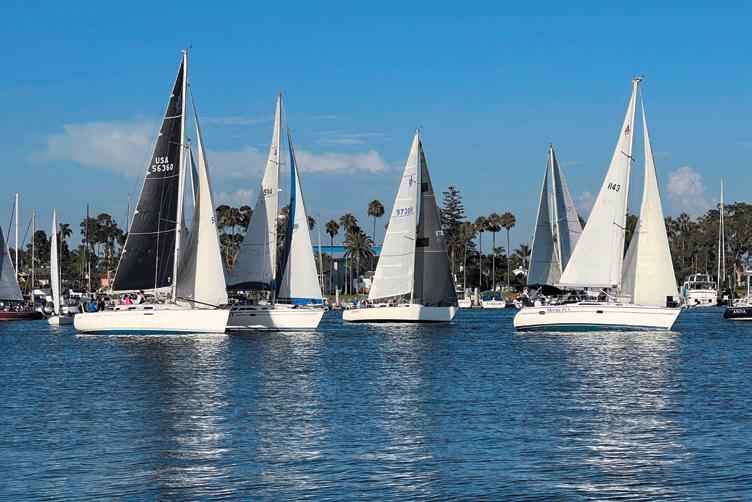
Coronado Yacht Club launches their race at 6 p.m. Depending on the wind, it might be a leisurely sail or a rip-roaring time in the bay. Sailors from other yacht clubs are also out, and boats from different clubs might pass each other in their separate races. Great viewing can be found on the promenade by Coronado City Hall, where
you can watch the boats leave Glorietta Bay, or the bayfront.
The Coronado Historical Association’s annual Mother’s Day historical homes tour showcases some of the city’s historical gems. If you can’t make it to the tour and want to appreciate National Preservation Month, learn about the city’s historical homes and more with CHA’s free Coronado’s Historical Gems app. You’ll find information on everything from the Donal Hord’s “Legends of California” mural along the side of Coronado High School to the cannons at Star Park — and maybe
With nearly 10,000 trees, Coronado has been named a Tree City USA since 1984.

even your neighbor’s house. The app includes a map, photos and descriptions.
One of the cool things about coming over the bridge into Coronado is looking over the impressive canopy of trees. Since June is National Great Outdoors Month, take a walk in the city’s urban forest. Coronado has been a designated as a Tree City USA since 1984, maintaining more than 8,500 trees on city property including parks and streets. The city is committed to planting 50 trees a year to keep the urban forest thriving. Trivia question: How many varieties of palm trees are native to Coronado? (Answer: zero.)
July marks the beginning of the summer open grunion season, which typically runs through August. That’s when you are allowed to catch the slippery little fish as they wash themselves ashore to lay eggs in the sand. The California grunion is the only fish that spawns out of the water. Grunion runs are typically during latenight high tides. You can catch grunions only with your bare hands and need a valid fishing license if you’re over 16. But be aware: Most people catch the fish for the challenge, not for the great taste.
Bike the Bay, a 25-mile ride that takes cyclists over the Coronado Bridge, is scheduled for the end of the month. But you don’t have to wait for the annual event to enjoy the route, which heads down the
Possums are beneficial for gardens, eating snails, slugs and small rodents.

Silver Strand on a designated bike path. At the south end of the Strand, you can come back the same way or go up the bay’s eastern side. By sure to stop to take in the views and read the informational signs explaining the history of the area and the San Diego Bay National Wildlife Refuge.
Now that the summer crowds have eased, it’s time to rediscover the city’s thriving wildlife population. At night, keep an eye out for possums (which will eat your garden pests), raccoons and skunks. Belding ground squirrels live in
Coronado is filled with small pocket parks, some with city views, where you can find a moment of solitude or gather with friends.

the rocks on Ocean Boulevard, and you might catch dolphins and an occasional sea lion swimming offshore. In the sky, look for birds of prey including hawks, osprey, kestrel and even great horned owls. September is also the time migratory birds such as grebes move in.
Get into the spirit of Halloween with,
well, a spirit. Check out the tours available at the Hotel Del to learn about the “Beautiful Stranger.” The mysterious Kate Morgan checked into the hotel on Thanksgiving Day in 1892 under an alias.
The 24-year-old had worked as a housekeeper in Los Angeles. Five days after she checked in, she was found with a gunshot wound to her head on a staircase outside. Since then, a lot of weird things have
happened in the room where she stayed, (now Room 3327) such as Morgan’s initials appearing on the ceiling.
In honor of Veterans Day, take a walk along 3rd and 4th streets on the west side of Orange Avenue to see the Avenue of Heroes banners. A new set of banners is installed every six months with a ceremony. The dozen banners honor veterans and active-duty service members, and the city takes nominees on a continuing basis. For more information, go to coronado.ca.us/216/ Hometown-Banner-Program. The Coronado Historical Association also has information about the banners at coronadohistory.org/. To expand your walking tour, also check out CHA’s map highlighting the homes of naval aviators.
Take a reprieve from the holiday parties, parades and purchases and find some quiet time at one of Coronado’s nearly two dozen parks. Many of the small triangle parks tucked into neighborhoods have no amenities, but they do have greenery to enjoy. Pack a picnic and get away from the crowds. Take some time to see if there’s a plaque commemorating the person for whom the park was named. Did you know that Pomona Park by Adella and Pomona avenues is officially called Mathewson Park, named after A.A. Mathewson, who opened the first grocery in town at 2nd Street and Orange Avenue and was also a city clerk? For a complete list of parks, go to coronado.ca.us/415/Parks-Beaches.
There’s always something to be discovered just beyond our backyards. Go out and explore. ■

A postcard of the 1915 Panama-California Exposition in Balboa Park includes the Sacramento Valley Building, which bordered the Plaza de Panama.
Jan. 18, 1913

For the preplanning stages of the Panama-California Exposition in Balboa Park, which opened in January 1915, officials from Sacramento came to San Diego to choose the site of the Sacramento Valley building on the exposition grounds. Visitors were wined and dined at Hotel del Coronado.
Jan. 26, 1923
W. F. Holland, proprietor of the Coronado Paint and Hardware Co., opened his newest store at the corner of Tenth Street and Orange Avenue. Simply

known as “Holland’s,” the store offered paint, hardware and a large stock of bicycles. Holland also sold pianos, phonographs, records and sheet music, as a subsidiary of the Thearle Music Co. in San Diego. When asked why his store carried such a diverse inventory, Holland replied, “Paint makes things more beautiful in the world. Bicycles give us vim and vigor and a thin waistline. Music soothes the mind and gives pleasure to guide us through the dance.”
Jan. 17, 1933
The enlisted Army personnel at
Rockwell Field moved into recently completed “bungalows” built from salvaged material. Constructed with tent frames that were boarded over, screened and topped with tar-papered roofs, the four-man buildings were more comfortable than tents.
remarked that some of the guest houses were built before any ordinances restricting them were adopted. City Manager Glenn Wade explained the crux of the problem is in policing. All agreed there was no easy solution to the problem.
Jan. 14, 1943
“Buy Bonds for a Bomber to be Named ‘The City of Coronado!’ ” was the slogan for the most intensive war bond drive conducted by the Coronado War Savings committee. It was part of the San Diego County War Committee’s goal to buy an entire squadron of Consolidated B-24 bombers, which would be named for communities throughout the county. Coronado’s aim was to sell $100,000 in bonds to assure “City of Coronado” was inscribed on the nose of a B-24.


Jan. 29, 1953
Guest houses, estimated to be about 100 around Coronado, were the subject of a joint conference between the City Council and Planning Commission. Councilman Walter Vestal said it was grossly unfair to tell homeowners that they cannot build a guest house on the back of their lot when a neighbor had illegally erected one next door. Planning Chairman Byron Johnson
The 90th birthday of Maude Lancaster was celebrated at Kippys clothing store. Cake and punch were served at the open house. Lancaster, one of Coronado’s most distinguished citizens, opened the city’s first hospital in 1926. She administered the facility on Orange Avenue for 15 years, until a larger hospital was opened in 1942.
Jan.
Protective scaffolding went up around the Reid Hotel at Orange and B avenues. Plans called for the 70-year-old structure, one of the city’s first major commercial buildings, to be leveled and replaced by a two-story Bank of America building. The original one-story structure was built in 1912 by Arizona cattleman Frank Moson, according to local historian Katherine Carlin. It was designed with distinctive arches. Occupying the retail spaces in the early days of the building were Coronado Dry Goods, photographer Lou Goodale Bigelow, Roy Burge’s barbershop, and a restaurant on the B avenue corner where Dick Klass “made the best hamburger in town.” Later, the arches were removed and a second story was added for the Reid Hotel, Carlin recalled. ■
ALBACA
Coronado Island Marriott Resort & Spa 2000 2nd St. (619) 435-3000
Amalo Brew Coffee Coronado Public Library 640 Orange Ave. (619) 537-9011
Avenue Liquor Wine & Subs 878 Orange Ave. (619) 435-4663
Bluewater Grill 1701 Strand Way (619) 435-0155
Boney’s Bayside Market 155 Orange Ave. (619) 435-0776
The Brigantine 1333 Orange Ave. (619) 435-4166
Burger King Ferry Landing 1201 1st St. (619) 435-8707
Burger Lounge 922 Orange Ave. (619) 435-6835
Calypso Cafe 505 Grand Caribe Causeway (619) 423-5144
Central Liquor & Deli 178 Orange Ave. (619) 435-0118
Chez Loma 1132 Loma Ave. (619) 435-0661
Chipotle 1360 Orange Ave. (619) 435-7778
Clayton’s Bakery and Bistro 849 Orange Ave. (619) 319-5001
Clayton’s Coffee Shop 979 Orange Ave. (619) 435-5425
Clayton’s Mexican Takeout 1107 10th St. (619) 437-8811
Cold Stone Creamery Ferry Landing 1201 1st St. (619) 437-6919
Coronado Brewing Co. 170 Orange Ave. (619) 437-4452
Coronado Coffee Co. Ferry Landing 1201 1st St. (619) 522-0217
Coronado Tasting Room Ferry Landing 1201 1st St. #101 (619) 534-5034
Costa Azul Ferry Landing 1201 1st St. (619) 435-3525
Crown Bistro Crown City Inn 520 Orange Ave. (619) 435-3678

Crown Landing Loews Coronado Bay Resort 4000 Coronado Bay Road (619) 424-4000
Crown Town Deli Ferry Landing 1201 1st St. (619) 675-0013
Danny’s Palm Bar & Grill 965 Orange Ave. (619) 435-3171
Domino’s Pizza 1330 Orange Ave. (619) 437-4241
Feast & Fareway Coronado Golf Course 2000 Visalia Row (619) 996-3322
Garage Buona Forchetta 1000 C Ave. (619) 675-0079
Gelato Paradiso 918 Orange Ave. (619) 629-5343
High Tide Bottle Shop & Kitchen 933 Orange Ave. (619) 435-1380
Hotel del Coronado 1500 Ocean Blvd.
• Babcock & Story Bar (619) 435-6611
• Eno Pizzeria (619) 522-8546
• Serea Coastal Cuisine (619) 435-6611
• Sheerwater (619) 522-8490
• Sundeck (619) 522-8039
• Beach Taco & Shack
• Sundae's Ice Cream & Gelateria
Il Fornaio 1333 1st St. (619) 437-4911
Island Pasta 1202 Orange Ave. (619) 435-4545
KFC/Taco Bell 100 B Ave. (619) 435-2055
Lil’ Piggy’s Bar-B-Q Ferry Landing 1201 1st St. (619) 522-0217
Little Club 132 Orange Ave. (619) 435-5885
Little Frenchie 1166 Orange Ave. (619) 675-0041
Lobster West 1033 B Ave. #102 (619) 675-0002
McP's Irish Pub 1107 Orange Ave. (619) 435-5280
Miguel’s Cocina 1351 Orange Ave. (619) 437-4237
Mindful Cafe Sharp Coronado Hospital 250 Prospect Ave. (619) 522-3600
MooTime Creamery 1025 Orange Ave. (619) 435-2422
Nado Gelato Cafe 1017 C Ave. (619) 522-9053
Nado Republic 1007 C Ave. (619) 996-3271
Nicky Rottens Bar & Burger Joint 100 Orange Ave. (619) 537-0280
Night & Day Cafe 847 Orange Ave. (619) 435-9776
Panera 980 Orange Ave. (619) 437-4288
Parakeet Cafe 1134 Orange Avenue (619) 675-0104
Parakeet Juicery West 1138 Orange Ave. (619) 537-0018
Parakeet Juicery East 943 Orange Avenue (619) 319-5931
Park Place Liquor & Deli 1000 Park Place (619) 435-0116
Poke123 1009 Orange Ave. (571) 221-4649
Rosemary Trattoria 120 Orange Ave. (619) 537-0054

Saiko Sushi 116 Orange Ave. (619) 435-0868
Serrano 126 Orange Ave. (619) 319-5955
Spiro’s Greek Cafe Ferry Landing 1201 1st St. (619) 435-1225
Starbucks 960 Orange Ave. (619) 437-8306
Stake Chophouse & Bar 1309 Orange Ave. (619) 522-0077
Subway 1330 Orange Ave. (619) 435-8272
Swaddee Thai 1001 C Ave. (619) 435-8110
Tartine 1106 1st St. (619) 435-4323
Tavern 1310 Orange Ave. (619) 437-0611
Tent City 1100 Orange Ave. (619) 435-4611
The Henry 1031 Orange Ave. (619) 762-1022
The Islander 1015 Orange Ave. (619) 437-6087
Trident Coffee 942 Orange Ave. (619) 509-7118
Villa Nueva Bakery Café 956 Orange Ave. (619) 435-1256
Village Pizzeria 1206 Orange Ave. (619) 522-0449
Village Pizzeria Bayside Ferry Landing 1201 1st St. (619) 437-0650
Which Wich 926 Orange Ave. (619) 522-9424
Wine a Bit 928 Orange Ave. (619) 365-4953
Yummy Sushi 1330 Orange Ave. (619) 435-2771
The THREE-COLOR TOP SHELL, also known as a calliostoma tricolor, is a small sea snail that grows to about a half-inch and has six whorls. A whorl is a complete revolution in a spiral, and it measures the shell’s growth. Whorls can be compared to growth rings in trees, but instead of growing out concentrically, they spiral down from the tip of the shell and get wider toward the bottom.
This beautiful little shell is one of the rarer beachcombing finds. With a brownish-orange background, the shell has a dashed whiteand-purple band that follows the whorls around the shell.
These mollusks can range from San Francisco to Northern Baja California, Mexico, and can be found in shallow intertidal waters as well as offshore to depths of 200 feet. This specimen was found near the tidepools in front of the Hotel del Coronado. ■
Class: Gastropoda
Order: Trochida
Family: Calliostomatidae Genus: Calliostoma Species: C. tricolor


Coronado’s shoreline changes with the weather, tides and time of year. Coronadobeachcomber explores our shores daily on the beach or at the bay, paying attention to the interesting animals, shells and sea life. Follow @coronadobeachcomber on Instagram.
 CORONADOBEACHCOMBER
CORONADOBEACHCOMBER

The dawning of a new year causes many of us to make dramatic vows and pledges. Some resolutions won’t even make it past the first weeks of January. But keeping resolutions for your rose garden should be a breeze.
A January rose pruning is therapeutic, symbolic and cleansing as well as enjoyable. We rid the garden (and symbolically ourselves) of last year’s old leaves and troubles while envisioning the promise and anticipation of beautiful new buds and blooms in spring. No wonder rosarians look forward to pruning; it is an annual ritual of love.
The other easy-to-keep rose resolution is improving the garden by selecting and buying new roses. In January, bare root roses are available in nurseries. This shopping opportunity provides the incentive to evaluate your present roses, remove deficient ones and replace them with well-selected varieties.
The Gertrude Jekyll rose has a strong scent and large blooms. DREAMSTIME

The Julia Child rose is a smaller variety with a licorice-like scent.

Pruning is enjoyable when you know why you need and how to do it. Pruning revitalizes roses, encourages the growth of more blooms, and opens plants to light and air circulation, which minimizes disease. Get started with these tips:
• Use the right tools. You’ll need a sharp pair of bypass pruners, gauntlet gloves, long-handled loppers and a pruning saw.
• Examine the rose from the bud union (the base of the plant below the branches, or canes). Keep healthy canes and cut out old, damaged, spindly ones. Unproductive canes need to be sawed out at the base of the bush, which encourages and opens
room for the rose to grow new, productive canes (basal breaks) from the bud union.
• Don’t prune severely. In San Diego, we generally cut about one-third off the height of hybrid teas and one-fourth off the height of floribundas, polyanthas, shrubs, miniatures and minifloras. On climbers, cut out main canes that are unproductive and damaged. The remaining canes are trained to grow horizontally, which encourages lateral growth. The blooms on climbers grow off these lateral stems.
• Look for the outward facing bud eye. Notice the small swelling where a leaf is or was attached to a cane? This is called
a bud eye. When pruning, make cuts one-quarter inch above an outward facing bud eye. This prompts the rose bush to grow in an outward direction, keeping the center of the bush open to air and light.
• Create a clean slate. Strip any remaining leaves on the bush and remove clippings from the garden to discard fungi and pests.
Don’t put up with a crummy rose. Do use this simple, three-prong query before you shovel-prune (dig the plant out):
• Could the rose’s non-performance be human error? If the answer is yes or maybe, give the rose a one-year reprieve and resolve to take better care of it.
• Did the rose make your heart sing? Did it produce lots of blooms, or at a minimum, were the scant blooms knockout gorgeous? If the answer is no, the rose must go. A rose should never be dull.
• Was the plant more trouble than it was worth? Don’t waste time on a rose that is a disease or pest magnet. Make way for a better rose.
Do your homework and consider the following:
• Do you desire a formal rose garden with high-centered hybrid tea roses? Perhaps a showy, breathtaking climber at the entry gate or on an arbor? Or is your vision multiclustered blooms of floribundas, polyanthas and shrub roses planted informally with other perennials?
Consider these events to help get you started:
• Pruning workshop. Pruning roses is best learned by watching the procedure and then practicing what you learned while being watched. Bring your gloves and pruners and attend the free annual hands-on pruning workshop presented by Master Gardeners and consulting rosarians at the Coronado Library Rose Garden, Jan. 14 from 9.30 to 11.30 a.m. Information about rose fertilizing, pests and fungal diseases will also be available. Master Gardeners will provide free cleaning and sharpening of one pair of pruners or loppers for workshop attendees. Tools need to be in good working condition.
• The San Diego Rose Society is hosting a rose growing seminar from 9:30 a.m. to 3:30 p.m. Jan. 21. Topics will include pests and disease, soil, fertilizer, and pruning techniques and tools as well as rose care throughout the year. The cost is $36, which includes lunch and refreshments. For details, go to sandiegorosesociety. com/events/rose-care-seminar.
 – Rita Perwich
– Rita Perwich
With proper care, the Sally Holmes climbing rose is nearly always in bloom.
• What types of bloom make your heart sing: the simplicity of single-petal blooms with brightly colored stamens; the individuality and fun of striped blooms; or romantic, fragrant, multipetaled roses?
If you’re like most rosarians, it’s probably all the above.
• Where will you plant the roses? Roses must be planted in a sunny location. Look up the size of a rose at maturity and assess your available space.
• Research the rose variety. Gardeners know that going to a nursery is like going to the grocery store when famished. Shopping for roses without a list can be a gamble because not all roses are equal in
disease resistance. Find the nursery’s rose list on the internet and check the varieties that meet your petal count, color, size and fragrance criteria.
Most importantly, research the variety on the internet. Is the rose described as being disease resistant? When disease resistance and fragrance are not mentioned, assume that they are lacking.
By prepping and planting roses now, you’ll set your garden up for a brilliant bloom in spring. ■
Rita Perwich is a Master Gardener with UC Cooperative Extension and a San Diego Rose Society consulting rosarian.


WHAT EVERYONE IS TALKING ABOUT

coronado365.com
